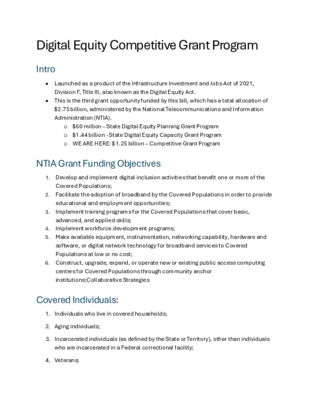Item 4: Briefing on DECA coalition NTIA grant proposal plan — original pdf
Backup

Digital Equity Competitive Grant Program Intro • Launched as a product of the Infrastructure Investment and Jobs Act of 2021, Division F, Title III, also known as the Digital Equity Act. • This is the third grant opportunity funded by this bill, which has a total allocation of $2.75 billion, administered by the National Telecommunications and Information Administration (NTIA). o $60 million – State Digital Equity Planning Grant Program o $1.44 billion - State Digital Equity Capacity Grant Program o WE ARE HERE: $1.25 billion – Competitive Grant Program NTIA Grant Funding Objectives 1. Develop and implement digital inclusion activities that benefit one or more of the Covered Populations; 2. Facilitate the adoption of broadband by the Covered Populations in order to provide 3. educational and employment opportunities; Implement training programs for the Covered Populations that cover basic, advanced, and applied skills; Implement workforce development programs; 4. 5. Make available equipment, instrumentation, networking capability, hardware and software, or digital network technology for broadband services to Covered Populations at low or no cost; 6. Construct, upgrade, expand, or operate new or existing public access computing centers for Covered Populations through community anchor institutions;Collaborative Strategies Covered Individuals: 1. Individuals who live in covered households; 2. Aging individuals; 3. Incarcerated individuals (as defined by the State or Territory), other than individuals who are incarcerated in a Federal correctional facility; 4. Veterans; 5. Individuals with disabilities; 6. Individuals with a language barrier, including individuals who— a. Are English learners; and b. Have low levels of literacy; 7. Individuals who are members of a racial or ethnic minority group; and 8. Individuals who primarily reside in a rural area. Eligibility to Apply 1. A political subdivision, agency, or instrumentality of a State, including an agency of a State that is responsible for administering or supervising adult education and literacy activities, or for providing public housing, in the State. 2. An Indian Tribe, an Alaska Native entity, or a Native Hawaiian organization (“Native Entity”). 3. A foundation, corporation, institution, or association that is – a. a not-for-profit entity; and b. not a school. 4. A community anchor institution. 5. A local educational agency. 6. An entity that carries out a workforce development program. 7. A partnership between any of the entities described in paragraphs (1) through (6). Applying entity must not be a current or past administrating entity for State Digital Equity Planning Grant Program or the State Digital Equity Capacity Grant Program Individual Award Amounts and Grant Period $5,000,000 - $12,000,000 is expected range, not required minimum or maximum. Awards outside this range are permitted, but must explain the variance with “compelling justification”. The Grant Period is for 4 years with an additional 1 year permitted for continuing evaluation. Cost Sharing/Matching and Budget Minimum required match is 10%. 20% and 30% committed match will each give an additional 0.1 multiplier for the score calculation. Match can be cash or in-kind (including volunteer time). There is a 10% cap on administrative expenses and a 10% cap on evaluation expenses. Performance Measurement and Evaluation Information collected should include: 1. The Covered Population(s) being served. 2. The total number of individuals being served. 3. The number of individuals that belong to each Covered Population. 4. For each activity or intervention, explain how the activity or intervention facilitates the purposes of the Digital Equity Competitive Grant program, specifically by promoting one or more of the following: a. Economic stability including workforce development and employment opportunities; b. Education access; c. Health care access; d. Social and civic engagement; e. Community access to the benefits of Internet technology. 5. Anecdotal/personal testimony demonstrating the positive experiences generated through the Program. 6. An assessment of Program effectiveness, including: a. Whether the grant’s intended objectives were accomplished, including whether it achieved its intended outcomes; b. Whether the program resulted in measurable changes in participants from the Covered Populations, such as in knowledge or skills, including collecting data before, during, and after the program to understand potential changes; c. Whether the activity or intervention is making/has made progress toward the goals and objectives of the grant; d. How efficiently the program achieved its goals. DECA Proposal • The Digital Empowerment Community of Austin is working on a collaborative application through weekly meetings that have been ongoing since 7/11/24. • 9 organizations are part of the core planning team (and there are more organizations who will be part of the solution). o Applying organization - Goodwill o Austin Free-Net o Human IT o Shining Light Consulting o Community Tech Network o Austin Mutual Aid o Premier Wireless o T-Mobile o City of Austin • We are in the process of finalizing an initial proposed structure which will likely include programming that meets the objectives of all 6 funding objectives. • We are focused on building something sustainable that will last beyond the period • Austin Public Library is also engaged and is interested in partnering on this of grant funding. proposal. Call to action: Please spread the word of this funding opportunity and of the work DECA is doing on this application through your networks. We will be seeking to build match for this opportunity, and will be looking for sources of cash and in-kind support (including volunteer time). Sustainability is a key focus of our proposal. If anyone is willing to volunteer time or support, please reach out. Contact For more information, contact Jesse Rodriguez at Jesse.Rodriguez@austintexas.gov .